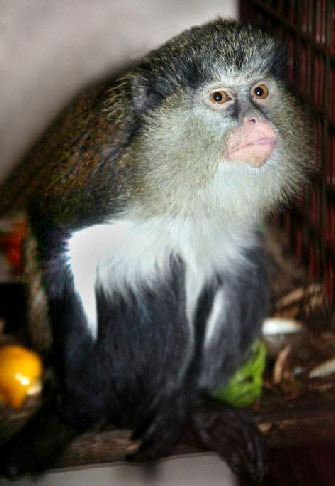

Mona Monkeys are small Old World monkeys native to West Africa, including Democratic Republic of Congo, Ghana, Uganda and Camaroon. They are members of the largest group of African primates which includes Baboons, Mangabeys, Drills, Mandrills and Macaques.
The relatively small size of Mona Monkeys makes them particularly prone to predation in the wild. The males grow to 600 cm in height and at around 5 kilos in weigh are around twice as heavy as the females. They have tails much longer than their bodies the largest males having tails up to 90 cms (36 inches) long.
Mona Monkeys have simple stomachs designed for digesting fruit, which makes up their main diet, although they will eat some flowers, soft leaves, nuts and insects.
They are quadrapedal, moving around on all fours and favouring primary and secondary forest and jungle habitats. They form groups of up to forty animals, but unlike many contemporary species there will only be one mature male in the group. The others will all be females and infants.
Chimpanzees will hunt and kill Mona Monkeys for food and yet Bonobos and Mona Monkeys will spend time peacefully together and alert each other to predators.
If they can avoid predation Mona Monkeys can live for at least 22 years in the wild
Our Mona Monkey pictured here is called Abene.
Like most forest dwelling primates they communicate vocally by the use of long distance, low frequency sounds aimed at other groups, and by shorter frequency sounds meant for their own group members.
These sounds are usually made by males and include a deep booming territorial sound intended to maintain distance between groups, and a “hack hack” call of higher frequency which only carries a short distance in thick forest and is usually a response to some form of disturbance, aimed at members of the same group.
Like most monkeys and apes Mona Monkeys also use a range of gestures and facial expressions to convey their feelings and intentions.
Staring open mouthed or yawning (see picture on right) often accompanied by head bobbing, is an expression of tension or a threat display.
Retracting the lips to show clenched teeth in a form of “grimace” is an expression of appeasement, intended to reduce aggression in others.

